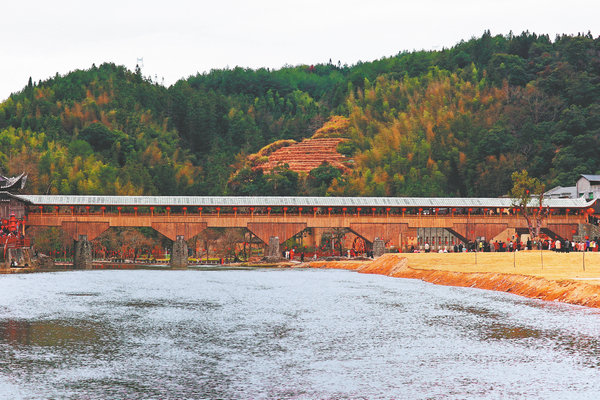

When Huang Minhui, 41, a city-level inheritor of wooden-arch bridge construction, heard in 2022 that Wan'an Bridge, which embodied the efforts of four generations of his family, had been damaged in a fire, he was heartbroken and his father, Huang Chuncai, 88, a national-level inheritor of the craft, had difficulty sleeping.
The Huang family has a deep bond with the old bridge, which was originally built during the Northern Song Dynasty (960-1127) and is the longest covered wooden-arch bridge in China.
The structure has suffered misfortune before and the family has always responded. In 1932, it was severely damaged in a fire, and Huang Minhui's great-grandfather and grandfather restored it. In 1952, when the bridge was partly destroyed in a flood, his grandfather and father were the main craftsmen involved in its restoration. Then in 2016, it was again restored by his father, his elder brother Huang Minping, and Huang Minhui himself.
Then, in 2022 there was the fire.
He and his brother played key roles in the six-month restoration project launched by the local government in July last year, leading to the bridge being reopened to the public.
During a meeting for the Three-Year Action Plan for the Protection of Covered Bridges (2023-25) in Pingnan county, Ningde, Fujian province, last month, Wan'an Bridge was highlighted as an example of technology meeting craftsmanship, and a drill was held to demonstrate the bridge's upgraded fire emergency mechanisms.
Spanning over the Changqiao Stream, the bridge links the villages of Changqiao and Changxing on either bank. It is an outstanding example of a wooden-arch bridge, a type of covered structure popular in northern Fujian and southern Zhejiang province, according to Lu Zeqi, an expert in cultural heritage in Pingnan.
Built out of interlocking short beams to create an arch without nails or rivets, its body is like an upside-down basket, and the resulting structure is able to efficiently spread weight loads.
"Using short logs, it's possible to make long bridges. This is a reflection of the skill of the people in the mountainous areas of Fujian and Zhejiang," Lu says.